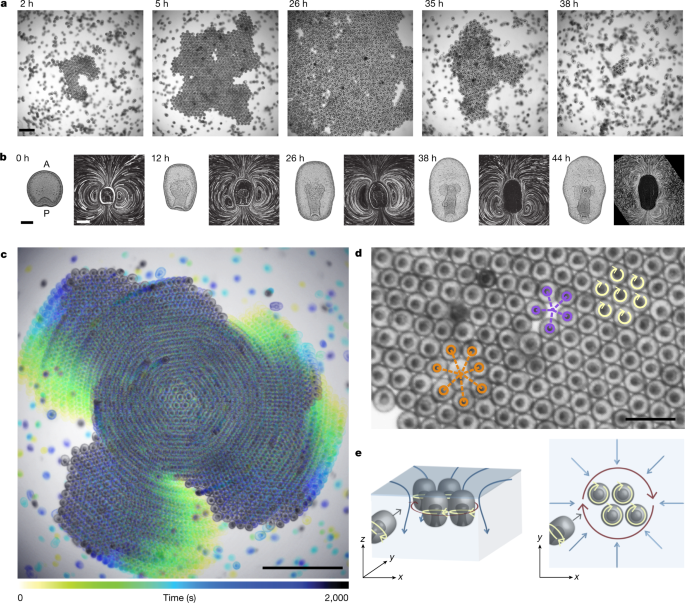
- Select a language for the TTS:
- UK English Female
- UK English Male
- US English Female
- US English Male
- Australian Female
- Australian Male
- Language selected: (auto detect) - EN
Play all audios:
Active crystals are highly ordered structures that emerge from the self-organization of motile objects, and have been widely studied in synthetic1,2 and bacterial3,4 active matter. Whether
persistent crystalline order can emerge in groups of autonomously developing multicellular organisms is currently unknown. Here we show that swimming starfish embryos spontaneously
assemble into chiral crystals that span thousands of spinning organisms and persist for tens of hours. Combining experiments, theory and simulations, we demonstrate that the formation,
dynamics and dissolution of these living crystals are controlled by the hydrodynamic properties and the natural development of embryos. Remarkably, living chiral crystals exhibit
self-sustained chiral oscillations as well as various unconventional deformation response behaviours recently predicted for odd elastic materials5,6. Our results provide direct experimental
evidence for how non-reciprocal interactions between autonomous multicellular components may facilitate non-equilibrium phases of chiral active matter.
All data that support the plots within this paper and other findings of this study are available from the corresponding author upon reasonable request.
The computational methods that support the plots within this paper are described in the Supplementary Information and the underlying code is available from the corresponding author upon
reasonable request.
We thank C. Scheibner, W. Irvine, N. Wingreen, J. Liu, Y.-C. Chao and R. E. Goldstein for valuable discussions. This research was supported by a Sloan Foundation Grant (G-2021-16758) to N.F.
and J.D., and a National Science Foundation CAREER Award to N.F. T.H.T. acknowledges support from the NSF-Simons Center for Mathematical and Statistical Analysis of Biology at Harvard
(award number 1764269) and Harvard Quantitative Biology Initiative as an NSF-Simons Postdoctoral Fellow. T.H.T. acknowledges support from the Center for Systems Biology Dresden as ELBE
Postdoctoral Fellow. A.M. acknowledges support from a Longterm Fellowship from the European Molecular Biology Organization (ALTF 528-2019) and a Postdoctoral Research Fellowship from the
Deutsche Forschungsgemeinschaft (Project 431144836). Y.C. acknowledges support from MIT Department of Physics Curtis Marble Fellowship. P.J.F. and S.G. acknowledge support from the Gordon
and Betty Moore Foundation as Physics of Living Systems Fellows through grant no. GBMF4513. J.D. was supported by the Robert E. Collins Distinguished Scholarship fund. N.F., J.D. and S.G.
are grateful to the KITP programme ACTIVE20: Symmetry, Thermodynamics and Topology in Active Matter, supported in part by the National Science Foundation under grant no. NSF PHY-1748958. We
thank the MIT SuperCloud43 for providing access to its HPC resources.
These authors contributed equally: Tzer Han Tan, Alexander Mietke
Department of Physics, Massachusetts Institute of Technology, Cambridge, MA, USA
Tzer Han Tan, Junang Li, Yuchao Chen, Hugh Higinbotham, Peter J. Foster, Shreyas Gokhale & Nikta Fakhri
Quantitative Biology Initiative, Harvard University, Cambridge, MA, USA
Department of Mathematics, Massachusetts Institute of Technology, Cambridge, MA, USA
N.F., J.D., T.H.T. and A.M. conceived the project. T.H.T. and A.M. are joint first authors. J.L. and Y.C. are joint second authors. T.H.T. designed and performed experiments and analysed
data. A.M. developed the theory, performed simulations and analysed data. J.L. performed experiments and analysed data. Y.C. analysed data. H.H. performed experiments. P.J.F. performed
experiments and analysed data. S.G. analysed data. N.F. and J.D. designed experiments and theory and supervised research. All authors discussed the results and co-wrote the paper.
Nature thanks Vivek Prakash, Anton Souslov and the other, anonymous, reviewer(s) for their contribution to the peer review of this work.
Publisher’s note Springer Nature remains neutral with regard to jurisdictional claims in published maps and institutional affiliations.
This file contains Supplementary Sections 1 -6, including: Experiment; Theory; Data Analysis; Table of symbols; Uncropped morphology images sections and legends for the Supplementary Videos.
Anyone you share the following link with will be able to read this content:







